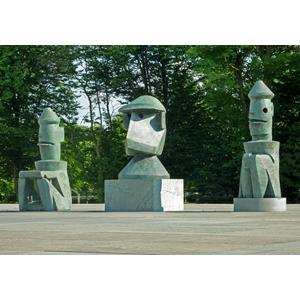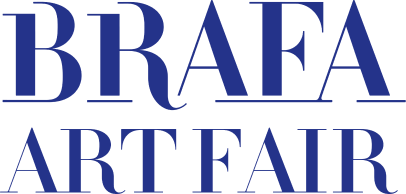DÉTAILS DE L'IMAGE

DIE GALERIE
Max Ernst (Brühl 1891-1976 Paris)
Corps enseignant pour une école de tueurs, 1967/2020
1967 - ensemble of sculptures in limestone (roche dure de Vilhonneur)
2020 - ensemble of sculptures in bronze
Bronze, Susse Fondeur Paris
Ex. 8/8
Ensemble consisting of:
Big Brother, H 150 x W 100 x D 94 cm (without plinth)
Séraphin le néophyte, H 198 x W 75 x D 75 cm (figure without eyes)
Séraphine-Cherubin, H 200 x W 80 x D 75 cm (figure with eyes)
Provenance: estate Max Ernst
Literature: Werner Spies, Max Ernst-Skulpturen, Häuser, Landschaften, Köln, 1998, p. 192, p. 210ff, p. 273; Jürgen Pech. Max Ernst. Plastische Werke, Köln, 2005, p. 194-201
In 1967, at Gilles Chauvellin's studio in Huismes, Max Ernst created a group of stone sculptures entitled Corps enseignant pour une école de tueurs (Faculty for a School of Murderers), which was exhibited at the Alexandre Iola’s gallery in Paris in 1968. The group consists of three 2 m high independent figures: Séraphin le néophyte, Big Brother and Séraphine-Cherubin, also called Big Sister. After the exhibition, the ensemble found its place near Max Ernst's last house in Seillans, in the south of France. The artist had long planned to produce a version of this group in bronze. The stone group thus became the model for a bronze ensemble, which was cast in the famous French Foundry Susse.
The mocking title and the impertinent mimic of the figures outline the group as something of an 'anti-monument' – fully in line with the critical and anarchic spirit of Max Ernst and Dadaism. The characters stand as representatives of a debatable authority that has been created through history. The figure of Big Brother, inspired by George Orwell's novel '1984', embodies totalitarianism and fascist surveillance. Max Ernst has put a cap on his head, which is fixed on the big ears and conceals the dark holes that replace his eyes. The whole figure is compact, flat, with smooth surfaces. To the right and left of Big Brother, Max Ernst had placed Séraphine-Cherubin and Séraphin le néophyte, both angels of light, who originally descended directly from God. Séraphine-Cherubin is slightly feminine, whereas Séraphin le néophyte is more of a masculine figure. Although they are both seated, they are still taller than Big Brother because of the conical hats they carry on their elongated heads. Mockingly, they stick out their tongues. They can be interpreted as personifications of an ecclesiastical authority that Max Ernst vehemently rejected.



 TÉLÉCHARGER L'IMAGE
TÉLÉCHARGER L'IMAGE